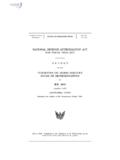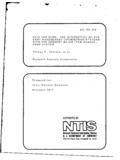Transcription of The '1033 Program,' Department of Defense …
1 The 1033 Program, Department of Defense Support to Law Enforcement Daniel H. Else Specialist in national Defense August 28, 2014 Congressional Research Service 7-5700 R43701 The 1033 Program, Department of Defense Support to Law Enforcement Congressional Research Service Summary The United States has traditionally kept military action and civil law enforcement apart, codifying that separation in the Posse Comitatus Act of 1878. On the other hand, Congress has occasionally authorized the Department of Defense (DOD) to undertake actions specifically intended to enhance the effectiveness of domestic law enforcement through direct or material support.
2 One such effort is the so-called 1033 Program, named for the section of the national Defense Authorization Act (NDAA) of 1997 that granted permanent authority to the Secretary of Defense to transfer Defense material to federal and state agencies for use in law enforcement, particularly those associated with counter-drug and counter-terrorism activities. The 1997 act was preceded by 1988 legislation that expanded DOD s role in the interdiction of illicit drug trafficking. That was soon followed by temporary authority to transfer excess Defense material, including small arms and ammunition, from excess DOD stocks to law enforcement agencies for use in counter-drug activities.
3 This could be done at no cost to the receiving agency. The 1997 NDAA expanded that authority to include counter-terrorism activities and made it permanent. It is codified as 10 2576a. The 1033 Program is administered by the Law Enforcement Support Office (LESO) of the Defense Logistics Agency (DLA). Under it, local and state law enforcement agencies may apply to DLA to participate. DLA requires the governor of the state to execute a Memorandum of Agreement (MOA) and appoint a state 1033 Program coordinator, who is responsible for ensuring that the program is properly administered within the state and that appropriate property records are maintained.
4 Approved agencies may request material from DLA through their state coordinators. The LESO retains final approval authority over the types and quantities of material transferred from DOD excess stocks to the agencies. Any material requiring demilitarization before being released to the public must be returned to DLA when no longer needed by the receiving law enforcement agency. LESO states that 11,000 agencies nationwide are currently registered and that 8,000 of them use material provided through the 1033 Program. The 1033 Program, Department of Defense Support to Law Enforcement Congressional Research Service Contents Department of Defense Support to Law Enforcement.
5 1 The 1033 Program .. 2 Materials Offered to Law Enforcement Agencies through the 1033 Program .. 2 Program Participants .. 3 Material Accountability .. 3 Congressional Reporting Requirements .. 4 Additional Information Resources .. 4 Appendixes Appendix A. Text of Section 1208 of the national Defense Authorization Act for 1990 ( 101-189) .. 5 Appendix B. Text of 10 2576a, Excess Personal Property: Sale or Donation For Law Enforcement Activities .. 6 Contacts Author Contact 7 The 1033 Program, Department of Defense Support to Law Enforcement Congressional Research Service 1 Department of Defense Support to Law Enforcement American tradition has long maintained a distinct separation between military force and civil law enforcement.
6 Nevertheless, federal troops were commonly used to enforce civil law during the years immediately after the Civil War, particularly in the states of the former Confederacy. The Posse Comitatus Act of 1878 (18 1385) was written to ensure that this practice would come to an Though the act codified an American tradition of separating military from civilian affairs, Congress has occasionally authorized the President to deploy military force to enforce, or assist in the enforcement, of various laws. For example, Congress has vested the Coast Guard, a federal armed force, with a broad range of law enforcement responsibilities. Congress has also passed statutes enabling the employment of military force in law enforcement support under specific circumstances, such as permitting the President to call out the armed forces in times of insurrection and domestic violence,2 or authorizing the armed forces to share information and equipment with civilian law enforcement One important example of congressional direction in the use of the armed forces to support law enforcement was seen in the enactment of the national Defense Authorization Act, Fiscal Year Title XI of the act tasked the Department of Defense (DOD)
7 To assume a prominent role in detecting and monitoring illegal drug production and trafficking. DOD became the single lead agency of the Federal Government for the detection and monitoring of aerial and maritime transit of illegal drugs into the United States, and the integrator of an effective system of command, control, communications, and intelligence assets dedicated to drug The act also placed Coast Guard law enforcement detachments aboard every appropriate surface naval vessel at sea in a drug-interdiction area and made available any equipment (including associated supplies or spare parts), base facility, or research facility of the Department of Defense to any Federal, State or local law enforcement official for law enforcement purposes.
8 6 Finally, it authorized additional DOD funding to the national Guard for drug interdiction and enforcement The following year, in the national Defense Authorization Act for Fiscal Years 1990 and 1991, Congress created a pathway for DOD to directly transfer to federal and state agencies equipment (so-called personal property ) that was excess to the needs of the Department and suitable for use 1 Posse comitatus refers to the customary English authority of a sheriff to summon the population of his county to his assistance to, for example, keep the peace or arrest felons. The act forbids the willful use of any part of the Army (later expanded to include the Air Force) as a posse comitatus or otherwise to execute the laws.
9 2 See 10 331-335. 3 See 10 371-382. For more information regarding the background and scope of the Posse Comitatus Act, see CRS Report R42659, The Posse Comitatus Act and Related Matters: The Use of the Military to Execute Civilian Law, by Charles Doyle and Jennifer K. Elsea. 4 Act of September 29, 1988, 100-456, 102 Stat. 1918. 5 Ibid., Section 1102 and Section 1103. 6 Ibid., Section 1104. 7 Ibid., Section 1105. The 1033 Program, Department of Defense Support to Law Enforcement Congressional Research Service 2 in counter-drug Under Section 1208, the Secretary of Defense could transfer Defense equipment, including small arms and ammunition, from existing Defense stocks without cost to the receiving agency.
10 In transferring such property, the Secretary of Defense was required to consult with the Attorney General and the Director of national Drug Control Policy (the federal government s so-called drug czar ).9 The act included a sunset provision that would have terminated this authority on September 30, 1992. This termination date was extended to September 30, 1997 by the enactment of Section 1044 of the national Defense Authorization Act for Fiscal Year The 1033 Program As the revised termination date approached, the 104th Congress considered making its authority permanent. The House version of the national Defense Authorization Act for Fiscal Year 1997 contained language ( 3230, Section 103) that would have expanded eligibility for property transfers to all law enforcement while retaining a priority for counter-narcotics activities.

















